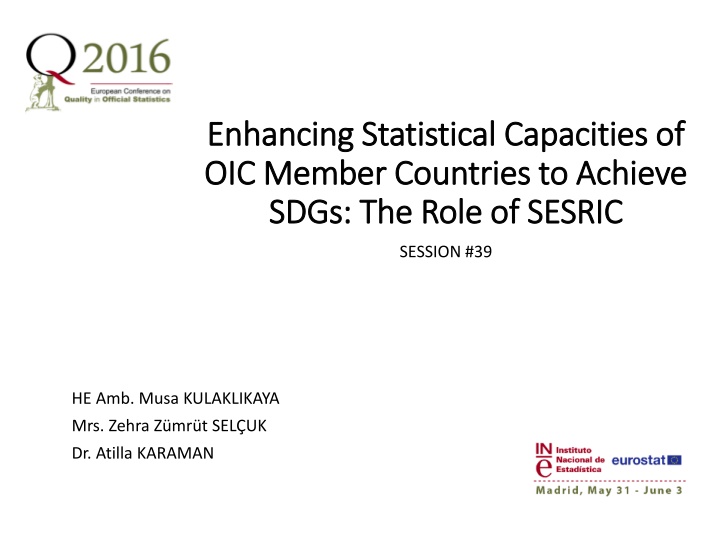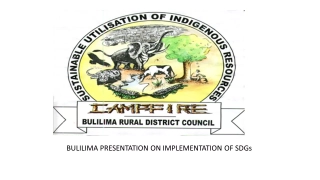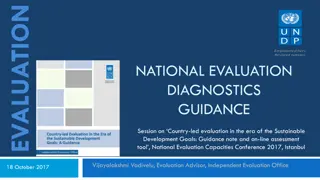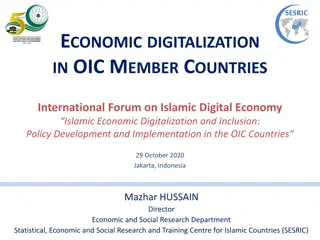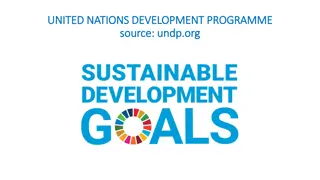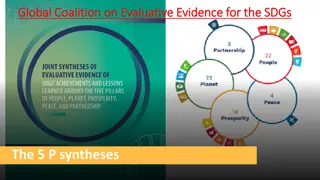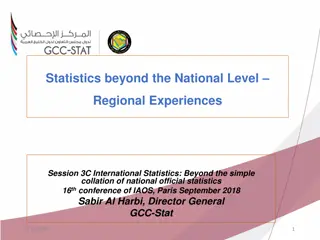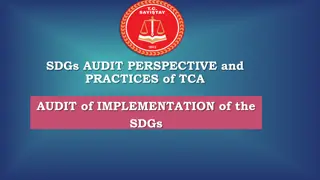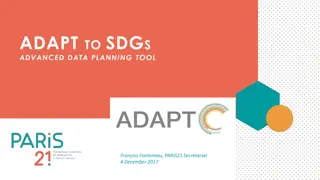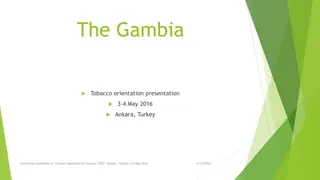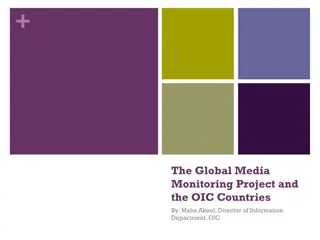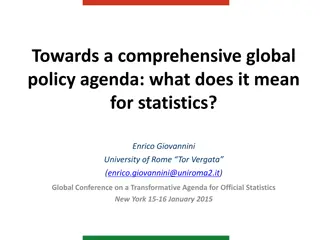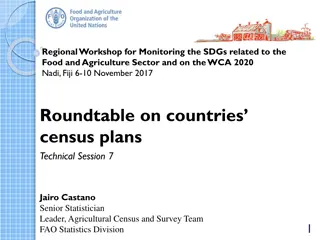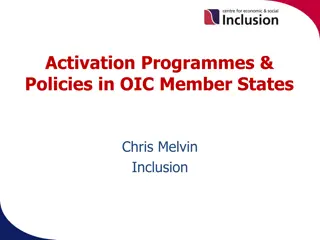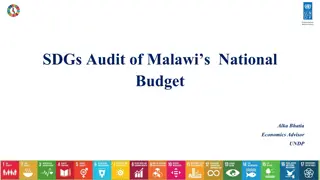Enhancing Statistical Capacities of OIC Member Countries to Achieve SDGs: The Role of SESRIC
This presentation discusses the importance of enhancing statistical capacities in OIC member countries to achieve Sustainable Development Goals (SDGs), with a focus on the role of SESRIC. It covers the evolution of statistical definitions, the use of Statistical Capacity Index (SCI) for analysis, and the methodology used in exploring data related to statistical capacities. The results highlight the significance of building strong statistical capacities for effective policy-making and monitoring progress towards SDGs.
Download Presentation

Please find below an Image/Link to download the presentation.
The content on the website is provided AS IS for your information and personal use only. It may not be sold, licensed, or shared on other websites without obtaining consent from the author.If you encounter any issues during the download, it is possible that the publisher has removed the file from their server.
You are allowed to download the files provided on this website for personal or commercial use, subject to the condition that they are used lawfully. All files are the property of their respective owners.
The content on the website is provided AS IS for your information and personal use only. It may not be sold, licensed, or shared on other websites without obtaining consent from the author.
E N D
Presentation Transcript
Enhancing Enhancing Statistical Capacities Statistical Capacities of OIC OIC Member Countries Member Countries to SDGs: SDGs: The Role The Role of of to Achieve Achieve of SESRIC SESRIC SESSION #39 HE Amb. Musa KULAKLIKAYA Mrs. Zehra Z mr t SEL UK Dr. Atilla KARAMAN
Enhancing Statistical Capacities of OIC Member Countries to Achieve SDGs: The Role of SESRIC CONTENTS INTRODUCTION MATERIALS & METHODS RESULTS THE ROLE OF SESRIC IN ENHANCING STATISTICAL CAPACITIES OF OIC MEMBER COUNTRIES TO ACHIEVE SDGs
INTRODUCTION Definition of statistics transformed in time due to changes in referent human activities Varying definitions reflect two histories: Social practice and advances in mathematical formalism Both definitions require a certain level of capacity MDGs underlined the role of national statistical capacities Different stakeholders assign different meanings to statistical capacity in line with their purposes SCI was used as input to analyse statistical capacities of OIC countries
MATERIALS & METHODS DATASET Data on Statistical Capacity Portal of World Bank Data available for Statistical Methodology (SM), Source Data (SD), and periodicity & timeliness (PT) dimensions together with overall SCI scores Data from 2004 to 2015 provided for 145 countries 50 OIC countries (OIC), 83 non-OIC developing countries (DEV), 12 high income countries (HIC) Analysis timeframe was from 2009 (start year with maximum number of OIC countries with available data) to 2015
MATERIALS & METHODS EXPLORATORY DATA ANALYSIS Overall SCI, SM, DS, and PT scores were explored using descriptive statistics Hierarchical agglomerative clustering (HAC) was applied on raw score data for year 2015 to group similar countries in SM, DS, and PT dimensions HAC considers performances of each country on its own and then combines them into clusters that maximize within-cluster similarity and between-cluster difference, as determined by a distance metric HAC algorithm was run on TANAGRA 1.4.50.
RESULTS DESCRIPTIVE STATISTICS
RESULTS DESCRIPTIVE STATISTICS
RESULTS Based on descriptive statistics, following criteria require sound actions to enhance statistical capacities of OIC countries: SM: Government Finance Accounting Concept, Import and Export Price Indexes, Industrial Production Index, and Special Data Dissemination Standard (SDDS); SD: Health Surveys, Poverty Surveys, and Vital Registration; and PT: Child Malnutrition (prevalence of underweight children under five), Gender Equality in Education (gross enrolment rate of girls to boys in primary and secondary education), Income Poverty, and Primary Completion Rate.
RESULTS HAC RESULTS Optimal number of clusters is 3 for SM, 4 for SD and 6 for PT based on highest gap obtained. Country clusters and respective sub-groups as per each K-means cluster can act as reference beneficiary country sets for implementation of statistical capacity building initiatives for related SM, SD, and PT criteria
RESULTS HAC RESULTS
The Role of SESRIC in Enhancing Statistical Capacities of OIC Member Countries to Achieve SDGs Bringing about the SDG indicator framework is not sufficient as countries should have capacity to feed data into monitoring and reporting mechanism Roles of international organisations in leveraging statistical capacities of their respective member countries gain more importance SESRIC tries to enhance the National Statistical Systems (NSSs) of the OIC member countries through combining resources from both its member countries and international organisations
The Role of SESRIC in Enhancing Statistical Capacities of OIC Member Countries to Achieve SDGs Statistical Capacity Building (StatCaB) Programme: South-South cooperation approach A twinning programme whereby the countries are matched according to their needs and capacities Initiated in early 2007 and so far, over 160 activities have been conducted 44 OIC countries have benefitted Contributed by 17 OIC countries and 12 regional/international organisations
The Role of SESRIC in Enhancing Statistical Capacities of OIC Member Countries to Achieve SDGs OIC Statistical Commission SESRIC organizes annual sessions of OIC-StatCom since 2011 together with Islamic Development Bank (IDB) Serves a platform for sharing experiences and best practices NSOs of OIC countries find an opportunity to exchange their views and to ignite mechanisms towards enhancing fruitful cooperation on statistical activities Directly contribute in multi-annual work plan of SESRIC in the field of statistics by shaping the Strategic Vision Document of the OIC-StatCom through their feedback
The Role of SESRIC in Enhancing Statistical Capacities of OIC Member Countries to Achieve SDGs OIC Statistical Commission Establishes communication channels between international organizations and OIC countries Initiated new projects with WHO on Tobacco Questions for Surveys (TQS) through support provided by CDC and CDC-F with Eurostat and UNSD on Peer Review for NSOs of OIC Member Countries (OIC-Peer) to facilitate a South-South M&E mechanism with IDB and OPHI on improving member countries capacities in multi-dimensional measurement of poverty, and with UNWTO on tourism satellite accounts for the Central Asia and South Asia regions of the OIC
The Role of SESRIC in Enhancing Statistical Capacities of OIC Member Countries to Achieve SDGs Specific Official Statistics Themes Relevant to OIC Islamic Banking and Finance Statistics Project Aims at developing a comprehensive database of Islamic financial industry Islamic finance can contribute to, among others, SDG-1/2/3 and 16 and innovative Islamic finance instruments can be used to mobilise resources to finance projects related to SDG-6/7/9 and 11 SESRIC shall be a bridge between the national data producers and international expertise agencies to furnish a sound methodology needed for the database
The Role of SESRIC in Enhancing Statistical Capacities of OIC Member Countries to Achieve SDGs Transformative Agenda for Official Statistics 46th Session of UNSC supported the implementation of the proposed Transformative Agenda for Official Statistics To support the efforts in achieving the SDGs by 2030, SESRIC also partners with the UNSD and UNESCWA to host the Arab Conferences on a Transformative Agenda for Official Statistics and to actively contribute to the efforts of its member countries in modernising their NSSs
THANK YOU THANK YOU Kud s Caddesi, No:9, Diplomatik Site, 06450 Oran, Ankara, Turkey http://www.sesric.org || http://www.oicstatcom.org statistics@sesric.org || secretariat@oicstatcom.org https://twitter.com/sesric || https://twitter.com/oicstatcom Telephone: (90-312) 468 61 72 Fax: (90-312) 467 34 58 and (90-312) 468 57 26
